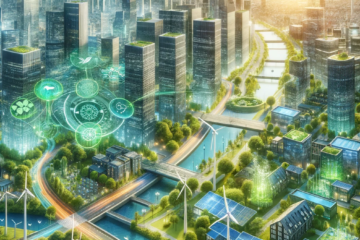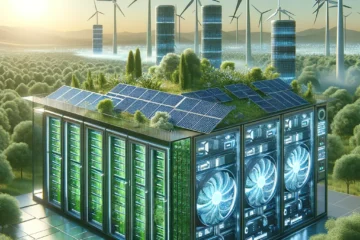In the shadow of a looming climate crisis, the future of urban landscapes is being reimagined through the lens of sustainability. As cities continue to expand vertically, the need for environmentally conscious design has never been more pressing. Eco-smart skylines represent a harmonious blend of human aspiration and ecological sensitivity, creating structures that not only reach towards the heavens but also root deeply in sustainable practices. This article explores how green buildings are being crafted to shape tomorrow’s urban environments, ensuring that the cities of the future are as kind to the planet as they are awe-inspiring.
Sustainable Architecture: The Foundation
Sustainable architecture is the bedrock upon which eco-smart skylines are built. This approach to building design is predicated on minimizing environmental impact and maximizing resource efficiency throughout a building’s life cycle—from planning and construction to operation and eventual demolition. Architects and engineers collaborate to infuse sustainability into every facet of design, choosing site locations that enhance natural light and ventilation while minimizing disruption to the existing ecosystem. These structures are designed with the future in mind, adaptable to both the evolving climate and the changing needs of urban populations.
In essence, sustainable architecture isn’t just about the materials used or the energy consumed; it’s about creating spaces that foster a deeper connection between occupants and the natural world. It prioritizes the health and wellbeing of inhabitants, incorporating elements such as green roofs, living walls, and ample green spaces. These features not only reduce the urban heat island effect but also improve air quality and provide residents with a tangible link to nature amidst the concrete and steel of city life.
Green Building Materials: Innovating Eco-Friendly
The quest for eco-smart skylines has driven innovation in green building materials, pushing the industry towards materials that are renewable, recycled, or have a lower carbon footprint. Timber, especially when sustainably sourced or engineered, is undergoing a resurgence due to its carbon-sequestering properties, enabling the construction of tall wooden structures known as “plyscrapers.” Other materials, like bamboo, recycled steel, and low-emission glass, are also gaining traction, offering strength and durability without the environmental toll of traditional construction components.
Moreover, the development of smart materials, such as self-healing concrete and thermochromic glass, is revolutionizing green construction. These materials not only reduce maintenance costs and extend the lifespan of buildings but also actively contribute to energy conservation. By employing advanced materials that respond dynamically to environmental conditions, architects can design buildings that are not only eco-friendly but truly intelligent, adjusting to their surroundings to minimize energy usage.
Energy Efficiency: The Core of Eco-Smart Design
At the heart of eco-smart skylines lies energy efficiency, a principle that guides the integration of renewable energy sources, such as solar and wind power, into building designs. Architects are creating structures with built-in photovoltaic panels and wind turbines, allowing skyscrapers to generate a significant portion of their own energy. High-performance insulation and glazing, coupled with energy-efficient HVAC systems, further ensure that these towering edifices are not energy sinks, but rather, models of sustainable consumption.
Intelligent building management systems are the nerve centers of these eco-smart giants, using sophisticated algorithms to monitor and control energy use across every aspect of the building’s operations. From lighting to elevators, every component is optimized for maximum efficiency, often employing predictive analytics to anticipate and adapt to usage patterns. This meticulous attention to energy flows not only reduces the carbon footprint but also sets a new standard for urban living, where the luxury of height is matched by the responsibility of stewardship.
Water Conservation in Modern Skyscrapers
Water conservation is a critical component of sustainable skyscraper design. Innovative water management systems are being implemented to reduce wastage and increase efficiency. These systems collect rainwater for reuse, treat greywater on-site for non-potable purposes, and incorporate low-flow fixtures to minimize consumption. Skyscrapers are transforming into self-sustaining ecosystems, closing the loop on water usage and setting a precedent for future developments.
Furthermore, water conservation efforts extend beyond the buildings themselves. By integrating with the larger urban infrastructure, eco-smart skyscrapers contribute to a city’s overall sustainability. Green roofs and permeable pavements reduce runoff, aiding in groundwater recharge and preventing the overtaxing of municipal sewer systems during heavy rainfall. In a world where water is becoming an increasingly scarce resource, these innovations are not just desirable but necessary for the long-term viability of urban centers.
Urban Biodiversity: Integrating Nature into Skylines
The incorporation of biodiversity into urban skylines is an emerging trend in green building design, aiming to create a symbiotic relationship between urban development and the natural environment. Eco-smart structures are designed with habitat creation in mind, featuring vertical gardens and sky parks which provide refuge for a variety of plant and animal species. These green oases not only enhance the aesthetic appeal of the buildings but also play a crucial role in maintaining ecological balance within the urban jungle.
By fostering urban biodiversity, these skyscrapers do more than just beautify the skyline; they tackle some of the fundamental challenges of urbanization, such as the loss of natural habitats and the decline of pollinator populations. Architects and city planners are recognizing the importance of these living systems not just for the environment, but for the mental and physical health of urban dwellers. Through the integration of nature into the very fabric of city life, eco-smart buildings are redefining what it means to live in harmony with the world around us.
The Future of Green Buildings: Trends and Visions
As we look to the future of green buildings, the trends are clear: sustainability will continue to drive innovation in architecture and urban planning. The buildings of tomorrow are envisioned as self-sufficient entities, equipped with the latest in renewable energy technology, waste reduction strategies, and biophilic design principles. Smart skins and responsive facades that adapt to changing weather patterns will become standard features, ensuring that buildings can dynamically alter their energy profiles to suit the needs of the moment.
In the vision of tomorrow’s eco-smart skylines, green buildings will be more than just individual towers of sustainability; they will be interconnected nodes within a larger, smart urban ecosystem. With the integration of the Internet of Things (IoT) and advances in data analytics, these structures will communicate with each other and with city infrastructure, optimizing resource use across the entire urban landscape. The future is one where green buildings not only contribute to the health of the environment but also form the backbone of resilient, adaptive, and thriving urban communities.
Crafting the green buildings of tomorrow is not simply an exercise in architectural prowess; it is a commitment to a future where human ingenuity and ecological responsibility coalesce into eco-smart skylines that inspire and sustain. With every sustainable foundation laid, every innovative material utilized, and every kilowatt-hour saved, we are constructing a legacy that transcends the mere physicality of buildings. These structures stand as testaments to a world where the urban experience is redefined, reflecting a deep-seated respect for our planet and an unwavering hope for a greener, more vibrant future for all.




